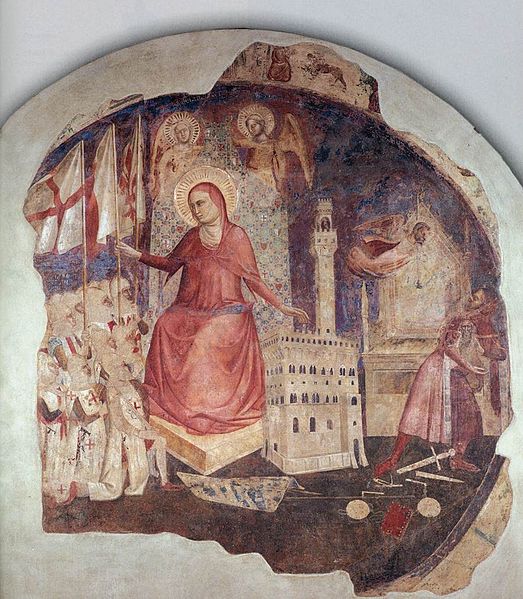Orcagna, Expulsion of the Duke of Athens
Table of Contents:

Orcagna
Expulsion of the Duke of Athens (1343)
The fresco of the Expulsion of the Duke of Athens was originally painted for the infamous Florentine debtor’s prison called the “Stinche,” located east of the Palazzo del Podestà. The name of the prison refers to the name of a castle in the mountains where a family of Ghibelline supporters resided. Debt was considered a major crime in early capitalist Italy, and being thrown in the Stinche designated an inmate as being a treacherous enemy of the comune. Thus, it is fitting that this fresco designed for the Stinche depicted a notorious threat to Florentine Republicanism: Walter of Brienne VI, also known as the Duke of Athens.
When Walter had arrived in Florence in 1342, the upper-middle class guild members who controlled the Florentine government expected him to preserve their power. However, the Duke ended up losing the support of the wealthy and commoners alike because of his insistence on raising taxes and acting as a despot. Notably, Walter angered members of the powerful Wool Guild by permitting lower class laborers to separate from the organization and form their own guild. The Florentine citizens finally managed to expel Walter on 6 August 1343, the Feast Day of St. Anne.
Scholars are unsure of the fresco’s artist, but most agree that the work was completed either by Orcagna or his master, Bernardo Daddi. The Expulsion of the Duke of Athens illustrates Walter turning his back towards the representation of the Palazzo della Signoria, the seat of the Florentine government. St. Anne, whose feast day on August 6 coincided with this rebellion, occupies the space to the left of the Palazzo, and to her right appear soldiers who await Anne’s order to expel the duke from the city. At Walter’s feet lie the emblems of justice that had been neglected through his rule, including the scales of justice and a book of law.
The similarities between this composition and other Judgment images in Tuscany are notable. In this allegorical image representing the commune’s intolerance for traitors, St. Anne acts as the stand-in for Florence, and the city of Florence, represented by the Palazzo della Signoria, becomes the judge. Saint Anne gestures to her right towards the Florentine citizens, who could be considered the “saved,” typically placed to the right of Christ in Last Judgment scenes. St. Anne gestures to her left towards the damned, which in this case is embodied by the disgraced Duke of Athens. Thus, the painting simultaneously acts as an illustration of a specific event and as an allegory for St. Anne’s role in helping the citizens banish a traitor from the city.
The image conforms to a type of painting called pitture infamanti, or “infamous pictures,” which proved to be a powerful way to punish criminals and warn others from committing the same crimes against the comune. Pitture infamanti punished criminals by representing them in a humiliating way that would be recognizable to viewers; these now-lost paintings were often attached to the sides of public buildings in order to be visible to the entire cities, and they often included degrading symbolic attributes of the criminal. Criminals who betrayed the public trust would be humiliated through these types of images, and their reputations would suffer.
While we are not entirely sure of this painting’s function within the Stinche, scholars are fairly certain that the image was located near the entrance on the inside of the prison and would have been seen by both prisoners and people visiting inmates. Notably, debtors could be expelled from Florence during this time, so prisoners and their friends and family had to contemplate this possibility while viewing this scene.
Bibliography
Bent, George. Public Painting and Visual Culture in Early Republican Florence. New York: Cambridge University Press, 2016. Pp. 107-108, 114-121.
Crum, Roger J. and Wilkins, David. “In the Defense of Florentine Republicanism.”
Freedberg, David. The Power of Images: Studies in the History and Theories of Response. Chicago: University of Chicago Press, 1989. Pp. 246-251.